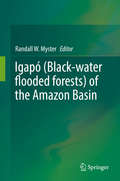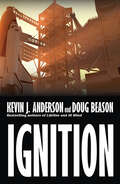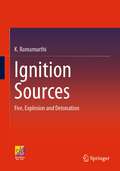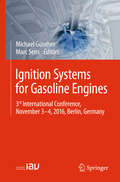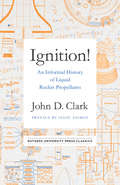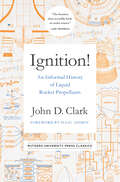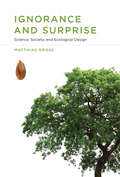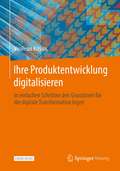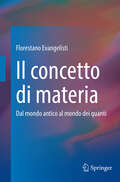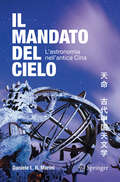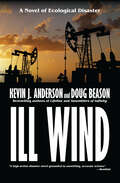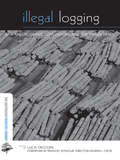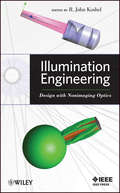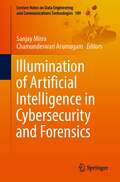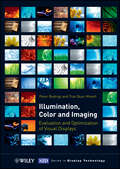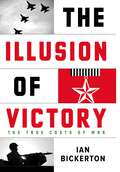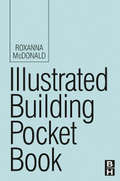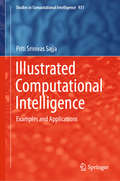- Table View
- List View
Igapó (Black-water flooded forests) of the Amazon Basin
by Randall W. MysterIgapó forests are a common part of the Amazon whose ecosystems are critical to our shared human future. The introduction addresses the structure, function and dynamics of igapó forests in the Amazon basin, focusing on their uniqueness due to their high level of complexity defined as the many ways that different components of igapó forests in the Amazon basin ecosystem interact and also on how those interactions are on a higher-order compared to other tropical forests. The text then breaks down the igapó ecosystem using these sections: (1) Igapó forests over space and time, (2) Water, light and soils, (3) The carbon cycle, (4) Litter, fungi and invertebrates, (5) Vertebrates, (6) Plant population studies, (7) Plant community studies, and (8) Human impacts and management. Experts from around the world serve as chapter authors that review what is known about their specific part of the igapó ecosystem, what research they have done, and also what needs to be done in the future.
Ignition
by Kevin J. Anderson Doug BeasonAn injured astronaut must save NASA from terrorists in this high-tech adventure by the bestselling authors of Lifeline and Ill Wind. Terrorists seize control of the Kennedy Space Center and hold the shuttle Atlantis and its crew hostage on the launchpad. But astronaut &“Iceberg&” Friese, grounded from the mission because of a broken foot, is determined to slip through the swamps and rocket facilities around Cape Canaveral and pull the plug on the terrorists. With their years of experience in the field, Anderson and Beason have packed Ignition with insider information to create an extremely plausible, action-packed thriller. &“Anderson and Beason have written a nail biter full of details about NASA and the Kennedy Space Center.&” —Library Journal
Ignition Sources: Fire, Explosion and Detonation
by K. RamamurthiThis book discusses the different energy sources bringing about fires, explosions, and detonations in combustibles under different levels of confinement. Focus is on the initiation source for a combustible whether it is a gas, a liquid, or a solid in a given state of confinement. Incidents of oxygen-related fires in hospitals which were particularly evident with increased usage of oxygen therapy for the extremely ill COVID-19 patients in 2021 are discussed with details of formation, accumulation, and dissipation of charges and their discharges leading to fires and explosions. Sympathetic detonations, BLEVE explosions, cook-off tests of combustibles, the inadvertent ignition sources (threats), and their control are discussed. Sporadic Ignition of wildfires in a heat dome augmented by the reflection of expansion disturbances from the interfaces separating media of different acoustic impedances are explored. Spontaneous human combustion, pilot ignition, shock wave ignition, ignition of fuel droplets and conditions under which fires, explosions, and detonations take place are discussed. Different ways of mitigating the inadvertent initiation of explosions and detonations are given at the end.
Ignition Systems for Gasoline Engines
by Michael Günther Marc SensThe volume includes selected and reviewed papers from the 3rd Conference on Ignition Systems for Gasoline Engines in Berlin in November 2016. Experts from industry and universities discuss in their papers the challenges to ignition systems in providing reliable, precise ignition in the light of a wide spread in mixture quality, high exhaust gas recirculation rates and high cylinder pressures. Classic spark plug ignition as well as alternative ignition systems are assessed, the ignition system being one of the key technologies to further optimizing the gasoline engine.
Ignition of Polymers (Springer Series on Polymer and Composite Materials)
by Peter RantuchThis book provides an overview of the initiation of combustion processes of polymeric materials. It presents physicochemical processes associated with heating as well as numerical methods for initiation parameter calculation. In addition, the book describes thermal degradation of polymers and the effect of an incident heat flux on initiation time. It then highlights the most commonly used devices for measuring the time to ignition using external heat sources. The target group of this book are scientists and researchers dealing with materials combustion and also graduates and practitioners focused on fire protection.
Ignition!: An Informal History of Liquid Rocket Propellants
by Isaac Asimov John Drury ClarkThis newly reissued debut book in the Rutgers University Press Classics Imprint is the story of the search for a rocket propellant which could be trusted to take man into space. This search was a hazardous enterprise carried out by rival labs who worked against the known laws of nature, with no guarantee of success or safety. Acclaimed scientist and sci-fi author John Drury Clark writes with irreverent and eyewitness immediacy about the development of the explosive fuels strong enough to negate the relentless restraints of gravity. The resulting volume is as much a memoir as a work of history, sharing a behind-the-scenes view of an enterprise which eventually took men to the moon, missiles to the planets, and satellites to outer space. A classic work in the history of science, and described as “a good book on rocket stuff…that’s a really fun one” by SpaceX founder Elon Musk, readers will want to get their hands on this influential classic, available for the first time in decades.
Ignition!: An Informal History of Liquid Rocket Propellants
by John Drury ClarkA classic work in the history of science, and described as “a good book on rocket stuff…that’s a really fun one” by SpaceX founder Elon Musk, readers will want to get their hands on this influential classic, available for the first time in decades. This newly reissued debut book in the Rutgers University Press Classics imprint is the story of the search for a rocket propellant which could be trusted to take man into space. This search was a hazardous enterprise carried out by rival labs who worked against the known laws of nature, with no guarantee of success or safety. Acclaimed scientist and sci-fi author John Drury Clark writes with irreverent and eyewitness immediacy about the development of the explosive fuels strong enough to negate the relentless restraints of gravity. The resulting volume is as much a memoir as a work of history, sharing a behind-the-scenes view of an enterprise which eventually took men to the moon, missiles to the planets, and satellites to outer space.
Ignorance and Surprise: Science, Society, and Ecological Design (Inside Technology)
by Matthias GrossThe relationship between ignorance and surprise and a conceptual framework for dealing with the unexpected, as seen in ecological design projects.Ignorance and surprise belong together: surprises can make people aware of their own ignorance. And yet, perhaps paradoxically, a surprising event in scientific research—one that defies prediction or risk assessment—is often a window to new and unexpected knowledge. In this book, Matthias Gross examines the relationship between ignorance and surprise, proposing a conceptual framework for handling the unexpected and offering case studies of ecological design that demonstrate the advantages of allowing for surprises and including ignorance in the design and negotiation processes.Gross draws on classical and contemporary sociological accounts of ignorance and surprise in science and ecology and integrates these with the idea of experiment in society. He develops a notion of how unexpected occurrences can be incorporated into a model of scientific and technological development that includes the experimental handling of surprises. Gross discusses different projects in ecological design, including Chicago's restoration of the shoreline of Lake Michigan and Germany's revitalization of brownfields near Leipzig. These cases show how ignorance and surprise can successfully play out in ecological design projects, and how the acknowledgment of the unknown can become a part of decision making. The appropriation of surprises can lead to robust design strategies. Ecological design, Gross argues, is neither a linear process of master planning nor a process of trial and error but a carefully coordinated process of dealing with unexpected turns by means of experimental practice.
Ihre Produktentwicklung digitalisieren: In einfachen Schritten den Grundstein für die digitale Transformation legen
by Vasileios KitsiosWelche Schritte müssen unternommen werden, um die Produktentwicklung effizienter, verlässlicher und vollständig digital durchzuführen? Dieses Fachbuch vermittelt die notwendigen Inhalte über Systeme, Prozesse und Tools, um in geeigneten Schritten eine vollständige Produktbeschreibung nach den Ein-Quellen-Prinzip zu erzielen. Anhand konkreter Fallbeispiele aus der Automotive und Luftfahrtindustrie wird das Konzept veranschaulicht und dem Leser wird die Umsetzung in 3DExperience R2021x und CATIA V5- 6R2019 demonstriert.
Il Banchiere e il Drago
by Martin LundqvistQuando emerge un nuovo virus, un uomo è destinato a cambiare il futuro. L'agente australiano Jared Pond viene inviato per indagare sulle voci su una nuova arma biologica cinese, il virus Hei Bai. Durante il suo incarico, Jared incontra e si innamora dell'attivista cinese per i diritti civili Eileen Lu, nemica del CPOC. Insieme, Jared ed Eileen cercano di scoprire gli oscuri segreti del malvagio dittatore Presidente Jing Xi e del suo assistente Tzi Cheng. Ma chi è Pierre Beaumont e qual è il legame tra la diffusione del virus e l'amministratore delegato della Banca mondiale?
Il Guardiano del Vento
by Silvia De Cristofaro Frank ScozzariIn California, una delle più grandi centrali nucleari negli Stati Uniti è presa di mira da un gruppo di terroristi. Aiutati da una talpa,il piano degli estremisti è quello di appropriarsi del reattore e spargere radiazioni nel vento, scatenando caos in tutto il mondo. L'unica cosa che si frappone al loro piano è una coppia di ufficiali di sicurezza ribelli,la cui fuga romantica li elimina temporaneamente dal radar dei terroristi. Dopo essersi resi conto di quello che è successo alla centrale, si ritrovano coinvolti in una battaglia contro il tempo e contro scenari terrificanti. Un'improvvisa rinascita di senso del dovere gli fa prendere le armi e li fa impegnare fino a un punto di non ritorno. Ma la loro chiamata all'azione è arrivata troppo tardi? Esponendo la vulnerabilità delle centrali nucleari della nazione,il Guardiano del Vento è un potente thriller di Frank Scozzari, che ha ricevuto quattro nomination per il Premio Pushcart.
Il concetto di materia: Dal mondo antico al mondo dei quanti
by Florestano EvangelistiIn questo libro si intende illustrare il lungo cammino che ha portato all’odierna concezione della materia, la cui determinazione rappresenta uno dei maggiori successi ottenuti dalla ricerca scientifica. Oggi, grazie alla meccanica quantistica e ai progressi della fisica e della chimica, abbiamo una conoscenza abbastanza precisa della struttura e delle proprietà della materia. Questa conoscenza è stata messa a punto in tempi relativamente recenti, pur essendo la risposta a domande antiche, alcune delle quali sono state poste contestualmente al sorgere della riflessione filosofica nella Grecia antica. Il lungo cammino, che ci ha portato all’acquisizione di questa conoscenza può essere diviso in tre fasi: la prima, temporalmente molto lunga, che è terminata alla fine del XIX secolo con la messa a punto della concezione della materia basata sulla fisica “classica”; la seconda, che ha visto la costruzione della “vecchia teoria dei quanti” nel tentativo di spiegare le proprietà della materia ed è terminata con la formulazione della moderna meccanica quantistica; la terza, in cui si è elaborata la moderna concezione quantomeccanica della materia atomica e nucleare. Tra gli argomenti trattati, che illustrano la prima fase sono: la riscoperta e l'appropriazione di conoscenze e concetti dell'antichità da parte della cultura occidentale in epoca moderna; il successivo processo di revisione nei secoli XVI e XVII e le nuove sperimentazioni e teorie del XVIII secolo; l’affermazione, nell’Ottocento, della visione di una materia composta da un numero preciso di sostanze elementari, gli elementi, dotati di proprietà fisiche e chimiche peculiari; la scoperta degli elettroni. Tra gli argomenti trattati, che illustrano la seconda fase sono: l’introduzione delle prime ipotesi di quantizzazione delle grandezze fisiche grazie a Planck ed a Einstein; la prima spiegazione delle proprietà della materia basata sugli assiomi di quantizzazione rappresentata dalla teoria di Bohr-Sommerfeld dell’atomo di idrogeno; la scoperta delle nuove proprietà quantomeccaniche della materia (lo spin dell’elettrone, il principio di esclusione e la dualità onda-particella); l’elaborazione moderna meccanica quantistica. Tra gli argomenti trattati, che illustrano la seconda fase sono: l’introduzione delle prime ipotesi di quantizzazione delle grandezze fisiche grazie a Planck ed a Einstein; la prima spiegazione delle proprietà della materia basata sugli assiomi di quantizzazione rappresentata dalla teoria di Bohr-Sommerfeld dell’atomo di idrogeno; la scoperta delle nuove proprietà quantomeccaniche della materia (lo spin dell’elettrone, il principio di esclusione e la dualità onda-particella); l’elaborazione della moderna meccanica quantistica.
Il mandato del cielo: L’astronomia nell’antica Cina
by Daniele L. MariniQuesto libro esplora la ricca e antica tradizione dell'astronomia cinese, sviluppatasi a partire dal terzo millennio prima dell'era corrente e documentata per la prima volta su ossa oracolari oltre 4.000 anni fa. Attraverso una sintesi storica e culturale, l'autore indaga l'evoluzione delle visioni cosmologiche cinesi fino all'arrivo dei missionari gesuiti alla fine del XVI secolo, evento che segnò l'inizio dell'incontro tra la scienza cinese e quella occidentale. Il libro analizza come la cosmologia e l'astronomia cinesi siano intrecciate con la cultura, la società e la filosofia del paese. Esplora il ruolo fondamentale dell'astronomia nella pianificazione del calendario e nei rituali religiosi e civili, e come l'enfasi cinese sulla previsione dei movimenti solari e lunari si distinguesse dall'approccio occidentale volto a comprendere le cause dei movimenti celesti. Attraverso capitoli dettagliati, il libro esamina i fondamenti della matematica antica, i metodi di osservazione e calcolo astronomico, e gli strumenti inventati dagli astronomi cinesi, come le armille e gli gnomoni. Infine, mette a confronto l'astronomia cinese e quella occidentale, evidenziando somiglianze e differenze nei metodi, nelle teorie e nei principi. Il mandato del cielo: L&’astronomia nell&’antica Cina offre un affascinante viaggio attraverso millenni di storia astronomica cinese, arricchendo la nostra comprensione di questa antica tradizione e della sua influenza sulla civiltà mondiale.
Ilan Ramon: Israel's First Astronaut
by Tanya Lee StoneStone tells of the first Israeli, Ilan Ramon, to travel to space.
Ill Wind: A Novel of Ecological Disaster
by Kevin J. Anderson Doug BeasonAn environmental disaster leads to global chaos in this science fiction thriller by the authors of Assemblers of Infinity. It is the largest oil spill in history: a supertanker crashes into the Golden Gate Bridge in San Francisco Bay. Desperate to avert environmental damage (as well as a PR disaster), the multinational oil company releases an untested designer oil-eating microbe to break up the spill. What the company didn&’t realize is that their microbe propagates through the air…and it mutates to consumer anything made of polycarbons: oil, gasoline, synthetic fabrics, plastics of all kinds. And when every piece of plastic begins to dissolve, it&’s too late . . . Praise for Ill Wind &“A high-action, best-seller-caliber disaster novel grounded in unsettlingly accurate science. . . . Using the standard disaster novel format of multiple characters and plot lines, Beason and Anderson maintain a suspenseful, breakneck pace that carries us to a thrilling finish.&” —Booklist&“A big, near-future disaster novel straddling the border between science fiction and technothriller, likely to appeal to fans of both.&” —Kirkus Reviews &“A real winner . . . [the authors&’] grasp of the science, the technology, and the political scene is unique.&” —Dr. D. Allan Bromley, former assistant to the president for science and technology
Illegal Logging: Law Enforcement, Livelihoods and the Timber Trade
by Luca Tacconi'This book carefully blends conceptual insights with extensive empirical evidence to navigate the reader through an issue that is still poorly understood [and is] a valuable reference for the development practitioner to understand the fundamental causes of illegal logging, its myriad consequences and the policy choices available to address the problem' Nalin Kishor, Forest Law Enforcement and Governance Coordinator, The World Bank 'An excellent resource for those working to conserve and sustainably manage forests worldwide. It offers an extensive and comprehensive study of illegal logging, bringing together the knowledge and views of experts who examine its roots and social, economic and environmental implications. One of its important contributions is to show that, unless coupled with reform of forestry regulations to take into account local people, law enforcement to curb illegal logging can negatively impact them. Therefore, any effective and fair approach to the problem needs to involve governments, forestry operators and local communities alike' Gonzalo Oviedo, Senior Social Policy Advisor, IUCN In many countries illegal logging now accounts for a large share of the harvest. Once cut, illegal logs feed an insatiable demand for exotic hardwoods in developed and developing countries. The result has been loss of both revenue and biodiversity, and consequently the issue has risen to the top of the global forest policy agenda as one of the major threats to forests, and donors and national governments are starting to develop initiatives to control illegal logging. Yet for such a massive illegal trade, there is surprisingly limited knowledge available as to the major causes of illegal logging and its impacts on biodiversity, people and livelihoods and national economies, and thus plenty of speculation and action without evidence. It is clear that while illegal logging does have negative impacts, it also, controversially, and perhaps paradoxically, benefits many stakeholders, including local communities. This book, written by the world's foremost experts, examines the key issues including law and enforcement, supply and demand, corruption, forest certification, poverty, local livelihoods, international trade and biodiversity conservation. It includes key case studies from forest-rich hotspots in North, South and Central America, equatorial Africa and Indonesia. While there are clearly no easy answers, this book sorts fact from fiction and explores the many dimensions of the causes, impacts and implications for forests, people, livelihoods and forest policy. Published with CIFOR
Illicium, Pimpinella and Foeniculum
by Manuel Miró JodralThe book includes current knowledge on Illicium verum (star anise) and Pimpinella anisum (aniseed), main commercial species rich in anetol. It also analyzes Foeniculum vulgare (fennel) and other species of Pimpinella (P. major, P. peregrina and P. saxifraga). This volume includes a botanical, chemical, pharmacological, and therapeutic survey of the
Illuminated Paris: Essays on Art and Lighting in the Belle Époque
by Hollis ClaysonThe City of Light. For many, these four words instantly conjure late nineteenth-century Paris and the garish colors of Toulouse-Lautrec’s iconic posters. More recently, the Eiffel Tower’s nightly show of sparkling electric lights has come to exemplify our fantasies of Parisian nightlife. Though we reflect longingly on such scenes, in Illuminated Paris, Hollis Clayson shows that there’s more to these clichés than meets the eye. In this richly illustrated book, she traces the dramatic evolution of lighting in Paris and how artists responded to the shifting visual and cultural scenes that resulted from these technologies. While older gas lighting produced a haze of orange, new electric lighting was hardly an improvement: the glare of experimental arc lights—themselves dangerous—left figures looking pale and ghoulish. As Clayson shows, artists’ representations of these new colors and shapes reveal turn-of-the-century concerns about modernization as electric lighting came to represent the harsh glare of rapidly accelerating social change. At the same time, in part thanks to American artists visiting the city, these works of art also produced our enduring romantic view of Parisian glamour and its Belle Époque.
Illumination Engineering
by R. John KoshelThis book brings together experts in the field who present material on a number of important and growing topics including lighting, displays, solar concentrators. The first chapter provides an overview of the field of nonimagin and illumination optics. Included in this chapter are terminology, units, definitions, and descriptions of the optical components used in illumination systems. The next two chapters provide material within the theoretical domain, including etendue, etendue squeezing, and the skew invariant. The remaining chapters focus on growing applications.This entire field of nonimaging optics is an evolving field, and the editor plans to update the technological progress every two to three years. The editor, John Koshel, is one of the most prominent leading experts in this field, and he is the right expert to perform the task.
Illumination of Artificial Intelligence in Cybersecurity and Forensics (Lecture Notes on Data Engineering and Communications Technologies #109)
by Sanjay Misra Chamundeswari ArumugamThis book covers a variety of topics that span from industry to academics: hybrid AI model for IDS in IoT, intelligent authentication framework for IoMT mobile devices for extracting bioelectrical signals, security audit in terms of vulnerability analysis to protect the electronic medical records in healthcare system using AI, classification using CNN a multi-face recognition attendance system with anti-spoofing capability, challenges in face morphing attack detection, a dimensionality reduction and feature-level fusion technique for morphing attack detection (MAD) systems, findings and discussion on AI-assisted forensics, challenges and open issues in the application of AI in forensics, a terrorist computational model that uses Baum–Welch optimization to improve the intelligence and predictive accuracy of the activities of criminal elements, a novel method for detecting security violations in IDSs, graphical-based city block distance algorithm method for E-payment systems, image encryption, and AI methods in ransomware mitigation and detection. It assists the reader in exploring new research areas, wherein AI can be applied to offer solutions through the contribution from researchers and academia.
Illumination, Color and Imaging
by Tran Quoc Khanh Peter BodrogiThis much needed, comprehensive and modern reference on display technology, illumination sources and color imaging focuses on visual effects and how reproduced images are best matched to human visual features.As such, it teaches readers how to exploit the knowledge of human color information processing to design usable, ergonomic, and pleasing displays or visual environments. The contents describe design principles and methods to optimize self-luminous visual technologies for the human user, including modern still and motion image displays, and indoor light sources. Design principles and methods are derived from the knowledge of the human visual system, with a special emphasis on color vision, color cognition, color harmony, color preference and visually evoked emotions. The expert authors include the most important and latest applications of the design principles and methods, forming a comprehensive view of human color information processing from the receptors through the retina via high-level visual perception right up to the level of cognition, preference, harmony, as well as visually evoked emotions. This book is included in the Wiley SID Series.
Illusion Of Victory: The True Costs of Modern War
by Ian BickertonThe Illusion of Victory demonstrates that most of the rewards of victory in modern warfare are either exaggerated or false. When the ostensible benefits of victory are examined a generation after a war, it becomes inescapably evident that the defeated belligerent rarely conforms to the demands and expectations of the victor. Consequently, long-term political and military stability is denied to both the victorious power and to the defeated one. As a result, neither victory nor defeat deter further outbreaks of war. This sobering reality is increasingly the case in the twentieth and twenty-first centuries. Ian Bickerton persuasively argues that as the rhetoric of victory becomes more hollow all countries must adopt creative new approaches to resolving disputes.
Illustrated Building Pocket Book (Routledge Pocket Books)
by Roxanna McDonaldBuilding and architecture has developed a language of its own, with terms and jargon that can confuse an expert let alone an outsider. Misunderstandings over what a word means can be irritating but unimportant, but could in the worst cases be costly or even dangerous.Traditional building dictionaries rely on the reader to already know what the correct word is, and that's not always the case. Roxanna McDonald's technique is radically different, and makes full use of the power of visual communication to convey information. Each stage of the building and design process is illustrated, and each hand-drawn illustration is carefully labelled with the relevant technical terms, to ensure that each term is used correctly and consistently by everyone working on a project.The 'Illustrated Building Pocket Book' is a radical approach to the age-old problem of the ambiguous use of technical language in building and architecture. By using drawings – which leave little room for ambiguity – clarity, safety and certainty can be achieved.
Illustrated Catalogue of Drawing Instruments: Architects and Engineers Materials
by John LylesOriginally developed in 1993 for an auction of an Architect's private collection of over 1,500 drawing instruments and calculators; this extensive book is one of a few comprehensive references available for comparative study of these instruments. The original collection was assembled over a twelve year period from sources in the US and Europe. Each instrument is listed in a scientific format for comparative evaluation and identification. An abbreviations table supports this approach. Profusely illustrated with 113 color photos and 61 highly organized text pages. The Subject Index has over 400 individualreferences dissecting this impressive collective of instruments from the 18th C. thru the mid 20th century. Instruments are categorized by Maker, Country, Period of Manufacture and function. Different instrument makers and suppliers are referenced to over 300 individual items. The four page Table of Contents provides a logical and extremely useful subjective summary of the catalog contents so that whatever the instrument or drawing tool, its location can be easily found. The photographs were taken with the idea of showing these important instruments in a comparative array. Researchers and collectors will find this a valuable resource. These instruments represent a most prolific period of time in our history of invention and advancements in technology. Computers are the new tools which demand a new pace of design and documentation.... They leave behind the centuries of drawing instruments that were the connection from the hand to the paper.
Illustrated Computational Intelligence: Examples and Applications (Studies in Computational Intelligence #931)
by Priti Srinivas SajjaThis book presents a summary of artificial intelligence and machine learning techniques in its first two chapters. The remaining chapters of the book provide everything one must know about the basic artificial intelligence to modern machine intelligence techniques including the hybrid computational intelligence technique, using the concepts of several real-life solved examples, design of projects and research ideas. The solved examples with more than 200 illustrations presented in the book are a great help to instructors, students, non–AI professionals, and researchers. Each example is discussed in detail with encoding, normalization, architecture, detailed design, process flow, and sample input/output. Summary of the fundamental concepts with solved examples is a unique combination and highlight of this book.
